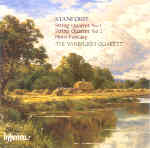Stanford’s first two string quartets, dating from 1891, are quite conservative in style, but that seems to have been part of his reason for writing them: throwing down the gauntlet in defense of the classical style. Once this point is understood, you can appreciate the fact that they contain some wonderful music. Stanford’s quartet style is fluent and never excessively dense (unlike Brahms), and best of all his tunes are truly memorable. The First quartet opens with a fresh, pastoral theme that calls to mind something Scandinavian, Grieg perhaps, while its finale is a vivacious Irish jig. Brahms looms larger, at least thematically speaking, in the Second quartet, whose scherzo and finale recall the similar movements in the First Serenade and Double Concerto, respectively. Nevertheless these stylistic parallels never sound merely derivative: Stanford’s own outgoing personality and rhythmic freshness gives each piece a personal cast.
The Fantasy for Horn Quintet (1922) is a gorgeous, 11-minute hunk of Romantic passion that’s amazingly colorful in tone and texture given the limited forces involved. Urgently expressive and beautifully written for the horn, it’s a serious addition to this noble instrument’s limited chamber music repertoire. Stephen Stirling plays his part with gusto and sensitivity to proper balances, and the RTÉ Vanbrugh Quartet displays obvious commitment as well as plenty of energy and affection. The string tone is a touch bright, as is the tremendously vivid recording, but I doubt anyone will mind given the interest of the repertoire. In fact, all three works are premiere recordings, and I find it a bit hard to believe that it has taken so long. Even if you dislike Stanford’s symphonies (patchy as they admittedly are), these expertly crafted pieces could well win you over to the cause. [5/3/2005]
































